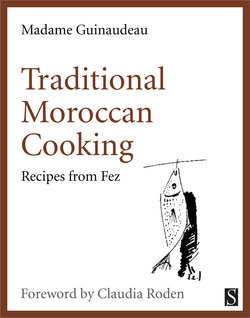Читать книгу Traditional Moroccan Cooking - Madame Guinaudeau - Страница 9
На сайте Литреса книга снята с продажи.
SPICES
ОглавлениеEyes filled with the harmonious green of the Chrabline minaret, we enter the bustling atmosphere of the Attarine souk.
Berbers smelling of mutton and cloves gaze with envy at the glittering beads, the bright materials, the motley trimmings. I stop there, drunk with the scent, colour and noise, and lean against the narrow edge of a shop between a sack of scarlet pimentos and a basket of rosebuds.
It is here that I have gathered the spices that you will use in the dishes which follow. I will give you, briefly, the names in English and Arabic and what I know of the origin of each. Doubtless there are errors in this work – to give you absolutely accurate information one would have to be both a botanist and an etymologist but I am only … a cook.
Insects, leaves, flowers, petals, seeds, roots and galls. China, India, Java, Egypt, black Africa, the gardens and valleys of Morocco, blending perfumes foreign to our European senses. Spices violent with all the wildness of the countries where they have ripened, sweet from the loving culture of the gardens where they have flowered, here is all the fascination of your dark kitchens, the odour of your streets. Spices are the soul of Fez.
Spices and aromatic plants used in cooking which do not go to make up ras el hanout:
Absinthe: chiba, the cultivated sort can replace mint in tea.
Ambrosia: mkhinza.
Aniseed: nafaa, this can be wild or cultivated in the Tafilalet.
Basil: hbeq zhiri.
Caraway seed: karoniya, found in the region of Meknès.
Citron: laranj, the juice is used to acidify olives.
Cloves: qronfel.
Coriander: qosbour, both the leaves and seeds are used for seasoning.
Cumin: kamoun, cultivated in the region of Marrakesh.
Fennel: bsbas, the wild variety.
Green Spanish aniseed: habbt hlawa, found in the region of Meknès.
Gum mastic: mksa.
Hemp: kif or hashish is used to make majoun.
Hot red pepper: felfla soudania, found in North Africa and Senegal.
Liquorice: arqsous, this is sucked by children and also used in cooking snails.
Mint: nana or iqama, the mentha viridis used in tea, the best is grown around Zerhoun, Sefrou and Meknès.
Parsley: madnousse.
Saffron: zafrane, from Sous and Spain.
Sage: salmiya, used as an infusion in tea.
Sesame: jljlan, cultivated in Chaouia.
Sharp hot red pepper: felfla harra, from the region of Marrakesh.
Sweet marjoram: mrdeddouch, perfumes the water in which snails are cooked.
Sweet red pepper, pimento or paprika: felfla hlouwa.
Thyme: zatr, abundant and scented in the mountains.
Verbena: louiza, an infusion.
Wild mint: fliou, peppermint.
